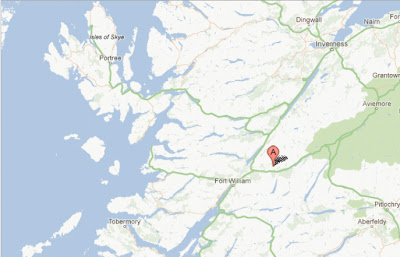On Friday 12 October 2012, a few minutes after 10.30 pm, British Summertime (a few minutes after 9.30 pm, GMT), the British Geological Survey recorded a Magnitude 1.3 Earthquake at a depth of 7 km close to the Highland village of Bohuntine, roughly 23 km northeast of Fort William. This is to small to present any danger to life or property, and quakes of this size often pass unnoticed, though on this occasion it was apparently felt in the village.
Map showing the location of the 12 October 2012 Earthquake. Google Maps.
Small Earthquakes are not uncommon in the UK, and become more common as you move north and west, making the west of Scotland the most quake-prone part of the country. The precise causes of quakes in Scotland can be hard to determine, as the tectonic behavior of the country is not dominated by a single geological feature, such as a plate margin, but rather subjected to stresses from a variety of different sources.
Scotland, along with the rest of Eurasia, is being pushed to the east by the expansion of the Atlantic Ocean, and to the north by the impact of Africa into Europe from the south. There are also lesser areas of expansion beneath the North Sea, the Bay of Biscay and the Rhine Valley, all of which exert tectonic pressures upon the UK to some extent. Finally there is glacial rebound; much of the north of Europe, including most of Scotland, was covered by thick glacial ice until about 10 000 years ago. This pushed the rocks of the Scottish lithosphere down into the underlying mantle. Now that this ice is gone the rocks are slowly rebounding, causing the occasional Earthquake in the process.
Witness reports of Earthquakes can help geologists to understand the processes going on during these events, and the rock structures that cause them. If you felt this quake (or were in the area but didn't, which is also useful information) then you can report it to the British Geological Survey here.
See also Earthquake near Dumfries, southwest Scotland, Two Earthquakes in Perthshire in two days, Small Earthquake in the Western Highlands, Small Earthquake on Islay, Earthquake in Argyllshire, west Scotland and Earthquakes on Sciency Thoughts YouTube.
Follow Sciency Thoughts on Facebook.

